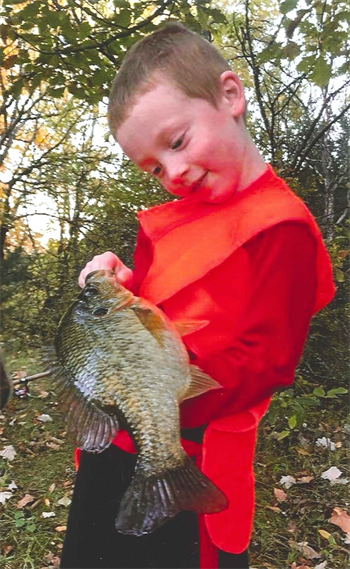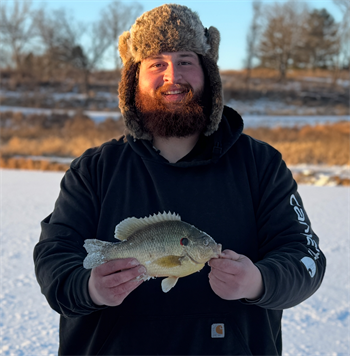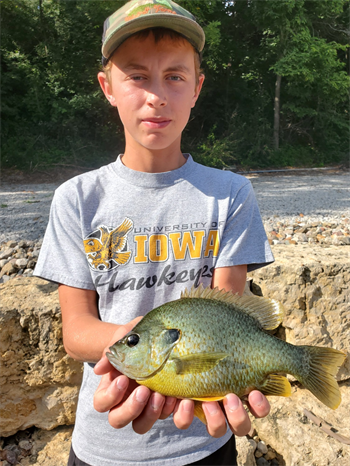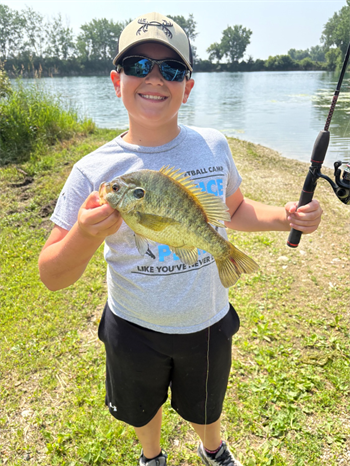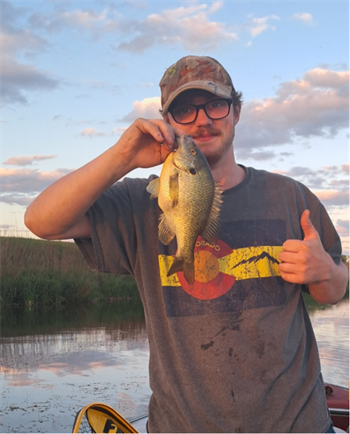Fish Iowa - Fish Species - Redear Sunfish
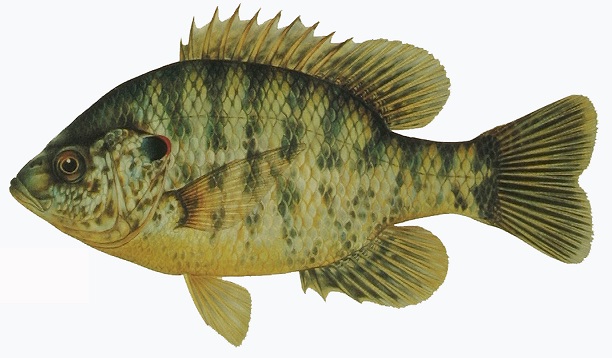
Characteristics
A deep, slab-sided sunfish with a small mouth similar in appearance to Bluegill and Pumpkinseed. The upper jaw does not reach past the front of the eye when the mouth is closed. The dorsal fin has 10 spines and is connected to the soft dorsal fin without the presence of a notch. The pectoral fins are pointed and long. The earflap is rounded and has a thin and flexible margin. The dorsal fin is without spots, and the sides of the head do not have bluish lines as in Pumpkinseed. The back and sides are golden or light olive-green, usually marked by several dark vertical bars. But these disappear in large fish. The ear flap has a whitish border and has a prominent red or orange spot in adults, hence the name redear. The fins are greenish without spots.
Foods
Young redear feed exclusively on zooplankton, but as they approach adulthood they eat more aquatic insect larvae, snails and cladocerans. Snails are a major food item in adults, which they crush with pharyngeal teeth, giving rise to the vernacular name shellcracker. In some small ponds, redear practically eliminate snails.
Expert Tip
- No results found
Details
Redear Sunfish are native from North Carolina to Florida, west into Texas, southern Missouri and Ohio. They are a recently introduced sunfish in Iowa waters. It was first propagated and stocked into the man-made recreational lakes in the early 1960's.
Redear spawn in late May and June when the water temperatures are 68 to 75 degrees. The males build a nest, usually grouped into colonies near submerged aquatic plants. Males usually release a "popping" sound when courting females. Females have an average of about 20,000 eggs, but as with other sunfish, it is unlikely that a female deposits all of her eggs in one nest. The eggs hatch in 6 to 10 days, and the fry stay in the nest guarded by the male. Redear growth is more rapid than Bluegill. They reach up to 2-inches in their first year, 4-inches the second, 6-inches in the third and 7-inches in the fourth year. Most redear mature in the second year of life.
Recent stream sampling information is available from Iowa DNR's biological monitoring and assessment program.
Distribution Map

Introduced into man-made recreational lakes in the 1960's; common to occasional in the southern two thirds of the state, mostly in the lakes that are steep-sided. Recorded in the interior streams, the origin of these fish is thought to be man-made lakes or ponds that overflow during periods of high runoff. It is very rare in the Missouri River and oxbows, as well as the Mississippi River.
See our most recent distribution data for this species on the Iowa DNR's Bionet application.
State Record(s)
Master Angler Catches
Fish Surveys
Tip: Click Species Length by Site, then use the dropdown to filter by fish species of interest.Where this Fish Is Found
Albia Lower Reservoir
Albia Upper Reservoir
Arti and Red's Pond
Badger Creek Lake
Banner Lake (north)
Banner Lake (south)
Big Hollow Lake
Bitternut
Black Oak
Central Park Lake
Cocklin Fish Farm
Cold Springs Lake
Diamond Lake
Diamond Lake Pond
East Nodaway River
Fogle Lake S.W.A.
Green Castle Lake
Grundy County Lake
Hacklebarney East
Hacklebarney West
Hannen Lake
Hooper Area Pond
Indian Hills Bridge Pond
Iowa Lake (Iowa Co.)
Johnston Pit
Kent Park Lake
Lacey Keosauqua State Park Lake
Lake Ahquabi
Lake Anita
Lake Belva Deer
Lake Darling
Lake Geode
Lake Iowa Pond
Lake Macbride
Lake Virginia
Lake Wapello
Lost Grove Lake
Marr Park Lake
Marr Park Pond
Medicine Creek Wetland
Nine Eagles Lake
Otter Creek Lake
Pollmiller Park Lake
Pony Creek Lake
Pool 18, Mississippi River
Pool 19, Mississippi River
Q Pond City Park
Red Haw Lake
Rodgers Park Lake
Shagbark
Springbrook Lake
Viking Lake
West Fork Grand River
West Lake (Osceola)
White Oak
Willow Lake
Stocking
9/26/2023 - Kent Park Lake: 6500 (size: 3)
9/26/2023 - Central Park Lake: 6500 (size: 3)
9/26/2023 - Otter Creek Park North Pond: 1375 (size: 3)
9/26/2023 - Otter Creek Park West Pond: 625 (size: 3)
9/26/2023 - Otter Creek Pond: 750 (size: 3)
9/25/2023 - Union Grove Lake: 22000 (size: 3)
9/25/2023 - Union Grove Lake: 29 (size: Adult)
10/5/2022 - Lake Darling: 21860 (size: 2)
9/28/2022 - Bluegrass Lake: 3000 (size: 2)
9/28/2022 - Lambach Lake: 2700 (size: 2)
9/28/2022 - Lake of the Hills: 16500 (size: 2)
9/28/2022 - Railroad Lake: 7500 (size: 2)
10/22/2021 - Lake Geode: 53760 (size: 2)
9/25/2020 - Big Hollow Lake: 22674 (size: 2)
9/25/2020 - Ringneck Ridge Pond: 1083 (size: 2)
9/25/2020 - Lake Belva Deer: 25737 (size: 2)
9/25/2020 - Lake Darling: 26829 (size: 2)
9/5/2019 - Hannen Lake: 16124 (size: 1.4)
9/5/2019 - Rodgers Park Lake: 7681 (size: 1.4)
9/5/2019 - Kent Park Lake: 9004 (size: 1.4)
9/5/2019 - Central Park Lake: 7336 (size: 1.4)
9/5/2019 - Central Park Pond: 2158 (size: 1.4)
9/5/2019 - Union Grove Lake: 29544 (size: 1.4)
10/21/2016 - Hannen Lake: 1900 (size: Fingerling)
10/21/2016 - Hannen Lake: 15 (size: Adult)
10/21/2016 - Rodgers Park Lake: 1100 (size: Fingerling)
10/21/2016 - Grundy County Lake: 2000 (size: Fingerling)
10/21/2016 - Gateway Park South: 2200 (size: Fingerling)
10/21/2016 - Lake Macbride: 18500 (size: Fingerling)
10/21/2016 - Mount Vernon Quarry: 250 (size: Fingerling)
9/3/2015 - Albia (upper): 2218 (size: 2")
9/2/2015 - Deep Lakes: 53157 (size: 2")
8/31/2015 - Lake Darling: 266241 (size: 2")
10/29/2013 - Lower Albia: 5635 (size: 2.0")
10/29/2013 - Upper Albia: 8225 (size: 2.0")
10/29/2013 - Lake Hawthorn: 40600 (size: 2.0")
10/23/2012 - Lost Grove Lake: 64116 (size: 0.8")
6/6/2012 - Hawthorn Lake (aka Barnes City Lake): 150 (size: Adults)
10/27/2009 - lake Wapello: 5287 (size: 2.6")
10/27/2009 - Albia Lake - Upper: 1702 (size: 2.6")
10/27/2009 - Albia Lake - Lower: 2532 (size: 2.6")
3/21/2007 - Viking Lake: 12000 (size: 1.5")
11/5/2003 - Anita: 50850 (size: 2"-3")
6/5/2003 - Pollmiller : 170 (size: Adult)
10/17/2002 - Mormon Trail Lake: 19800 (size: 1.6")
10/17/2002 - West Lake Osceola: 13800 (size: 1.6")
10/17/2002 - Hacklebarney - East: 3000 (size: 1.6")
10/16/2002 - Belva Deer Lake: 115200 (size: 1.6")
10/15/2002 - Blue Heron Lake: 144480 (size: 1.5")
10/14/2002 - Red Haw Lake: 40025 (size: 2.5")
9/26/2001 - Hacklebarney - East: 1000 (size: 1.1"-3.2")
